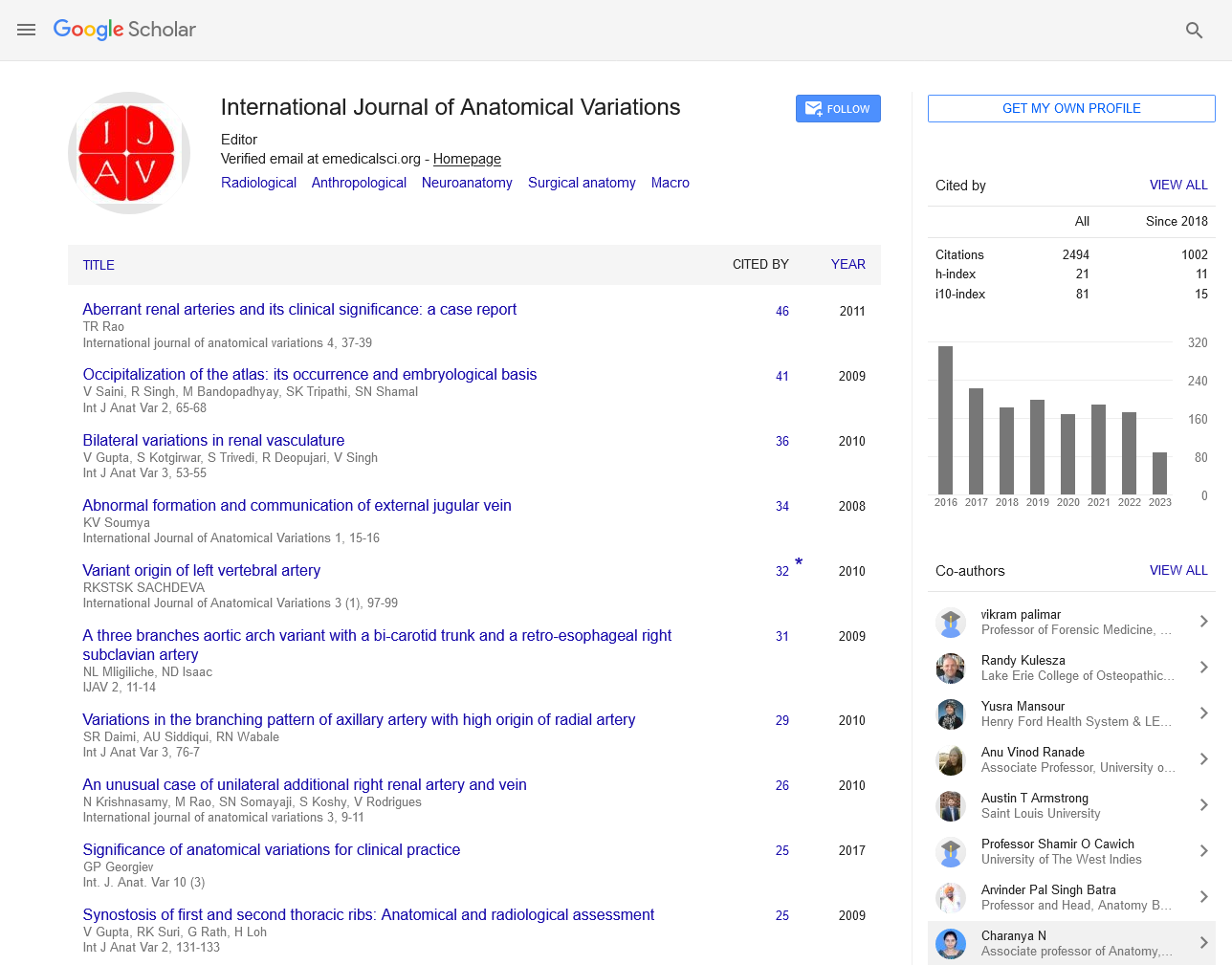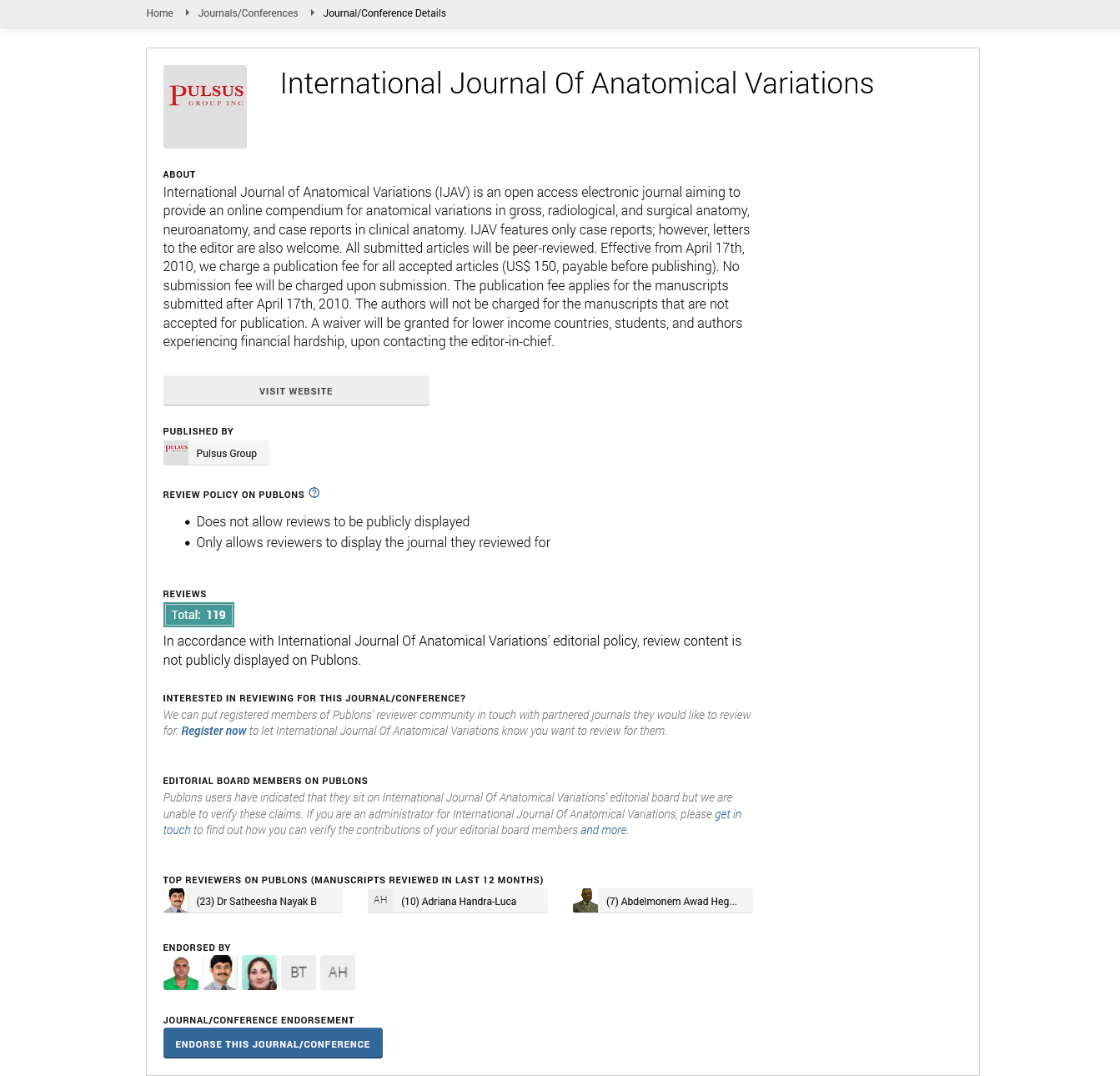A Comprehensive Overview of Human Anatomy: Structure, Function, and Clinical Relevance
Received: 01-Mar-2025, Manuscript No. ijav-25-7638; Editor assigned: 04-Mar-2025, Pre QC No. ijav-25-7638 (PQ); Reviewed: 19-Mar-2025 QC No. ijav-25-7638; Revised: 26-Mar-2025, Manuscript No. ijav-25-7638 (R); Published: 30-Mar-2025, DOI: 10.37532/1308 4038.18(3).496
Citation: Hendry J. A Comprehensive Overview of Human Anatomy: Structure, Function, and Clinical Relevance. Int J Anat Var. 2025; 18(3): 762-763.
This open-access article is distributed under the terms of the Creative Commons Attribution Non-Commercial License (CC BY-NC) (http://creativecommons.org/licenses/by-nc/4.0/), which permits reuse, distribution and reproduction of the article, provided that the original work is properly cited and the reuse is restricted to noncommercial purposes. For commercial reuse, contact reprints@pulsus.com
Abstract
Human anatomy, the scientific study of the structure of the human body, serves as a foundational pillar in medical and health sciences. This article provides a detailed overview of the major systems of the human body, including the skeletal, muscular, nervous, cardiovascular, respiratory, digestive, endocrine, urinary, and reproductive systems. Emphasis is placed on anatomical terminology, intersystem relationships, and the clinical relevance of anatomical knowledge. The paper aims to bridge classical anatomical understanding with modern medical applications, incorporating insights from imaging technologies and cadaveric studies.
INTRODUCTION
Human anatomy has been a cornerstone of biological and medical science since ancient times. Understanding the structural organization of the human body is critical not only for physicians and healthcare providers but also for researchers in various fields of biology, biomechanics [1], and bioengineering. The discipline is traditionally divided into gross (macroscopic) anatomy, microscopic anatomy (histology), and developmental anatomy (embryology). This paper explores the structure and functional aspects of human anatomy, aiming to elucidate the complexity of the human body and its clinical significance [2].
ANATOMICAL TERMINOLOGY AND ORIENTATION
Standardized anatomical terminology allows precise and universal communication in medical and scientific contexts. Terms like anterior/posterior, superior/inferior, medial/lateral, and proximal/distal describe the location and orientation of body parts relative to each other. The human body is typically examined in the anatomical position—standing upright, facing forward, arms at the sides, and palms facing anteriorly [3].
SYSTEMS OF THE HUMAN BODY
Comprising 206 bones in the adult human body, the skeletal system provides structural support, protection for internal organs, and a framework for muscle attachment. It also plays roles in mineral storage (calcium and phosphate) and hematopoiesis within bone marrow. The muscular system includes skeletal, cardiac, and smooth muscles. Skeletal muscles facilitate voluntary movements and posture, cardiac muscle sustains heart contractions, and smooth muscles regulate the movement of substances through internal organs. The central (CNS) and peripheral (PNS) nervous systems coordinate body functions through electrical and chemical signals. The brain and spinal cord comprise the CNS, whereas the PNS includes sensory and motor neurons. Neurons, synapses, and neuroglial cells form the cellular foundation. This system transports oxygen, nutrients, hormones, and waste products throughout the body. It consists of the heart, blood vessels (arteries, veins, capillaries), and blood. The heart’s four chambers maintain a unidirectional blood flow regulated by valves. The respiratory tract includes the nasal cavity, pharynx, larynx, trachea, bronchi, and lungs. Its primary function is gas exchange—oxygen intake and carbon dioxide expulsion—at the alveolar-capillary interface. The digestive system breaks down food, absorbs nutrients, and eliminates waste. It includes the oral cavity, esophagus, stomach, intestines, liver, pancreas, and gallbladder. Enzymatic and mechanical processes drive digestion and absorption. Glands such as the pituitary, thyroid, adrenal, and pancreas secrete hormones that regulate metabolism, growth, stress responses, and reproductive functions. Unlike the nervous system, endocrine signaling is slower but has longer-lasting effects. This system maintains homeostasis by filtering blood, excreting waste (urea, creatinine), and regulating electrolyte and fluid balance. It includes the kidneys, ureters, bladder, and urethra. Distinct in males and females, the reproductive system supports gametogenesis, hormone production, and reproduction. Male organs include the testes, vas deferens, and penis, while female organs include ovaries, fallopian tubes, uterus, and vagina [4].
MICROSCOPIC ANATOMY AND HISTOLOGY
Histological analysis reveals cellular organization within tissues and organs. Four basic tissue types—epithelial, connective, muscle, and nervous tissue—form all organs and structures. Staining techniques like H&E and immunohistochemistry are vital for identifying tissue architecture and pathology [5].
DEVELOPMENTAL ANATOMY AND EMBRYOLOGY
Embryology studies human development from zygote to fetus. Key processes include cleavage, gastrulation, organogenesis, and fetal maturation. Birth defects and congenital anomalies often result from disruptions in these developmental stages.
TECHNOLOGICAL ADVANCES IN ANATOMICAL SCIENCE
Modern imaging techniques such as MRI, CT, and ultrasound have transformed anatomical studies and clinical diagnostics. Virtual dissection tools, 3D anatomical modeling, and augmented reality applications enhance education and surgical planning.
CLINICAL RELEVANCE OF ANATOMY
Understanding anatomy is essential in surgery, radiology, emergency medicine, and physical therapy. Variations in anatomical structures must be considered in clinical diagnoses and treatment planning. Anatomical knowledge also underpins innovations in regenerative medicine and prosthetics.
ETHICAL CONSIDERATIONS AND CADAVERIC STUDIES
The use of cadavers in anatomical education raises ethical considerations around consent and respect for human remains. Nonetheless, cadaveric dissection remains a gold standard for medical training, providing tactile and spatial awareness of human structures.
CONCLUSION
Human anatomy is a dynamic and integrative field, central to the practice and advancement of medicine. As technologies and educational tools evolve, the study of anatomy continues to deepen our understanding of the human body and its complex interrelationships. Future directions point toward personalized anatomical modeling, advanced simulations, and integration with genetic and molecular data for a truly holistic understanding of human biology.
REFERENCES
- Mamikonyan VR, Pivin EA, Krakhmaleva DA. Mechanisms of corneal neovascularization and modern options for its suppression. Vestn Oftalmo. 2016; 132(4):81-87.
- Jun S, Zhang-Y, Chuan C. Postoperative neovascularization, cerebral hemodynamics, and clinical prognosis between combined and indirect bypass revascularization procedures in hemorrhagic moyamoya disease. Clin Neurol Neurosurg. 2021 Sep; 208:106869.
- Xin W, Bofu L. Aortic Dissection with Rare Anatomical Aortic Arch Variation Depicted by Computed Tomography Angiography. Heart Surg Forum. 2021; 24(2): E407-E408.
- Foivos I, Jonathon K, Daryll B. Aberrant right subclavian artery - a rare congenital anatomical variation causing dysphagia lusoria. Vasa. 2021; 504(5):394-397.
- Schizas N, Patris V, Lama N. Arc of Buhler: A lifesaving anatomic variation. A case report. J Vasc Bras. 2012; 37(11):9-326.
Indexed at, Google Scholar, Crossref
Indexed at, Google Scholar, Crossref
Indexed at, Google Scholar, Crossref
Indexed at, Google Scholar, Crossref






